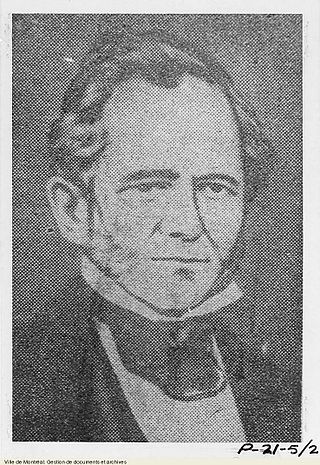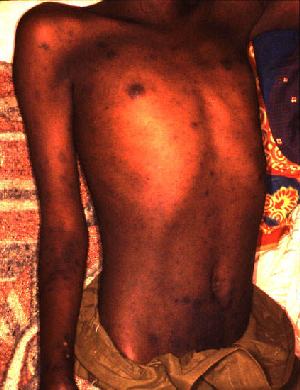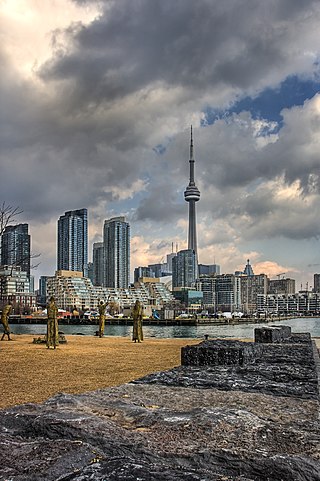Related Research Articles

Epidemic typhus, also known as louse-borne typhus, is a form of typhus so named because the disease often causes epidemics following wars and natural disasters where civil life is disrupted. Epidemic typhus is spread to people through contact with infected body lice, in contrast to endemic typhus which is usually transmitted by fleas.

Events from the year 1847 in Canada.

John Easton Mills served briefly as mayor of Montreal, Quebec.

A coffin ship is a popular idiom used to describe the ships that carried Irish migrants escaping the Great Irish Famine and Highlanders displaced by the Highland Clearances.

Irish Canadians are Canadian citizens who have full or partial Irish heritage including descendants who trace their ancestry to immigrants who originated in Ireland. 1.2 million Irish immigrants arrived from 1825 to 1970, and at least half of those in the period from 1831 to 1850. By 1867, they were the second largest ethnic group, and comprised 24% of Canada's population. The 1931 national census counted 1,230,000 Canadians of Irish descent, half of whom lived in Ontario. About one-third were Catholic in 1931 and two-thirds Protestant.

Irish Quebecers are residents of the Canadian province of Quebec who have Irish ancestry. In 2016, there were 446,215 Quebecers who identified themselves as having partial or exclusive Irish descent in Quebec, representing 5.46% of the population.

A pest house, plague house, pesthouse or fever shed was a type of building used for persons afflicted with communicable diseases such as tuberculosis, cholera, smallpox or typhus. Often used for forcible quarantine, many towns and cities had one or more pesthouses accompanied by a cemetery or a waste pond nearby for disposal of the dead.

Grosse Isle is an island located in the St. Lawrence River in Quebec, Canada. It is one of the islands of the 21-island Isle-aux-Grues archipelago. It is part of the municipality of Saint-Antoine-de-l'Isle-aux-Grues, located in the Chaudière-Appalaches region of the province.

Goose Village was a neighbourhood in Montreal, Quebec, Canada. Its official but less commonly used name was Victoriatown, after the adjacent Victoria Bridge. The neighbourhood was built on an area formerly known as Windmill Point, where thousands of Irish immigrants died from disease in 1847 and 1848. The entire neighborhood was demolished in 1964 as part of preparations for Expo 67, to be replaced by a football stadium and parking lot.

Typhus, also known as typhus fever, is a group of infectious diseases that include epidemic typhus, scrub typhus, and murine typhus. Common symptoms include fever, headache, and a rash. Typically these begin one to two weeks after exposure.

Death or Canada is a two-part Canadian–Irish docudrama which was broadcast in Ireland on RTÉ One in November/December 2008. In the UK on The History Channel UK in January and February 2009 as Fleeing The Famine. The film was also featured as part of the celebrations for Toronto's 175th anniversary.

Ireland Park is located on the shores of Lake Ontario on Éireann Quay, adjoining the Canada Malting Silos, at the foot of Bathurst Street in Toronto, Ontario, Canada. Officially opened in the summer of 2007, Ireland Park commemorates the tens of thousands who fled Ireland during the Great Famine. In 1847, over 38,000 Irish men, women and children landed at Rees's Wharf on the shores of Toronto, fleeing famine and eager to start a new life. Although Toronto only had approximately 20,000 residents at the time, the city welcomed the newcomers with open arms. Over 1,100 new immigrants did not survive to make Canada their new home, with many perishing in fever sheds during the Typhus epidemic of 1847. Ireland Park is a tribute to all the Irish ancestors who came with only hope, for a new life in a promising country.

The Irish Commemorative Stone is a monument in Pointe-Saint-Charles, island of Montreal, Quebec commemorating the deaths from "ship fever" (typhoid) of 6,000 mostly Irish immigrants to Canada during the immigration following the Great Irish Famine in the years 1847-1848.
Hannah was a brig, launched at Norton, New Brunswick, Canada in 1826. She transported emigrants to Canada during the Irish Famine. She is known for the terrible circumstances of her 1849 shipwreck, in which the captain and two officers left the sinking ship aboard the only lifeboat, leaving passengers and the rest of the crew to fend for themselves.
Looshtauk was an Irish emigrant ship, captained by John M. Thain, sailing from the Port of Liverpool to the Port of Quebec on April 17, 1847. 462 passengers boarded at Liverpool. Typhus was caught by two male passengers in Liverpool and broke out during the crossing. Scarlet fever also erupted.

Diseases and epidemics of the 19th century included long-standing epidemic threats such as smallpox, typhus, yellow fever, and scarlet fever. In addition, cholera emerged as an epidemic threat and spread worldwide in six pandemics in the nineteenth century.

The Carriage of Passengers Act of 1855 was an act passed by the United States federal government on March 3, 1855, replacing the previous Steerage Act of 1819 and a number of acts passed between 1847 and 1849 with new regulations on the conditions of sea transportation used by passenger ships landing in the United States. The law was passed by the 33rd United States Congress and signed into law by President Franklin Pierce.
Grasett Park is situated at the corner of Adelaide Street West and Widmer Street in downtown Toronto, Canada. It is a public space that commemorates Dr. George Robert Grasett who, in the summer of 1847, gave his life to care for Irish migrants fleeing the Great Famine, many of whom arrived in Toronto sickened or dying from typhus, then known as ship fever. At the time, Toronto had merely 20,000 residents, and thus struggled to accommodate the more than 38,000 migrants who arrived in 1847 alone.
Constantia was launched at Swansea in 1816. She sailed as a coaster, and across the Atlantic, making at least two voyages bringing immigrants to Canada. In April 1832, she was the first of four ships that arrived at Quebec within a month with passengers having died of cholera. She and the vessels that followed her introduced the 1826–1837 cholera pandemic to North America as it spread from Quebec to the rest of Canada and down to the United States. She was last listed in 1848.
References
- ↑ "M993X.5.1529.1 | The government inspector's office". McCord Museum . Montreal . Retrieved 22 January 2012.
- 1 2 3 4 5 Cecil Woodham-Smith: The Great Hunger – Ireland 1845–1849, published by Penguin Books, 1991 edition
- 1 2 3 4 Robert Whyte's 1847 Famine Ship Diary: The Journey of an Irish Coffin Ship, published by Mercier Press, 1994
- 1 2 3 The Grosse Île Tragedy by J. Jordan, 1909
- ↑ Quebec Gazette, 23 July 1847
- ↑ The Voyage of the Naparima by James Magnan, published by Carraig Books in 1982.
- ↑ The Great Shame by Thomas Keneally, published by Vintage in 1999
- 1 2 3 Gallagher, The Reverend John A. (1936). "The Irish Emigration of 1847 and Its Canadian Consequences". CCHA Report, University of Manitoba Web Site. Retrieved 23 March 2008.
- ↑ Bruemmer, Rene (30 May 2009). "Seeking hope, they found death". Montreal Gazette. Canwest. Archived from the original on 24 October 2013. Retrieved 30 May 2009.
- 1 2 McMahon, Colin. "Montreal's Ship Fever Monument: An Irish Famine Memorial in the Making" The Canadian Journal of Irish Studies Vol. 33, No. 1, Ireland and Quebec / L'Irlande et le Québec (Spring, 2007), pp. 48–60
- ↑ Montreal Irish walk in remembrance of coffin ship victims Irish Central, 23 July 2009. Retrieved on 6 February 2011.
- ↑ "The Typhus Epidemic 1847". Toronto's Historical Plaques. Heritage Toronto. 1997. Archived from the original on 29 April 2019. Retrieved 21 January 2012.
- ↑ "The UnderTOw: The Fever Sheds". BlogTO. 11 April 2007. Retrieved 21 January 2012.
- ↑ "1967.25A-C | Partridge Island". McCord Museum . Montreal. Retrieved 22 January 2012.
- ↑ "The Typhus Epidemic 1847". Ontario's Historical Plaques. Archaeological and Historic Sites Board of Ontario. Archived from the original on 19 October 2013. Retrieved 24 January 2012.
- ↑ Arthur L. Gelston; Thomas C. Jones (December 1977). "Typhus Fever: The Report of an Epidemic in New York City in 1847". Journal of Infectious Diseases . 136 (6): 813–821. doi:10.1093/infdis/136.6.813. JSTOR 30107065. PMID 336803.